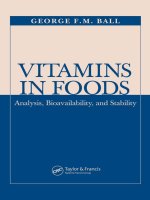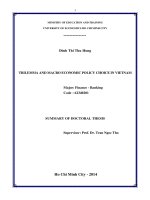vitamins and macro minerals
Bạn đang xem bản rút gọn của tài liệu. Xem và tải ngay bản đầy đủ của tài liệu tại đây (638.31 KB, 27 trang )
Vitamins and Minerals
General Concepts
• Divided into two major groups: fat soluble and
water soluble
• fat soluble: A, D, E, K
• most of the 15 shown as essential for fish, but not
for all species
• requirements vary with species, size, growth rate,
environment (temperature, presence of toxins,
etc.) and metabolic function (growth, stress
response, disease resistance)
• many species can utilize intestinal bacteria
synthesis for meeting vitamin requirements
Vitamin A: retinol
• Can only be found intact in animal sources
• in its natural form, it is alcohol known as retinol
• also isolated from various lipids and beta carotene
– 1 beta carotene (plants) ~ 2 retinols (body)
•
•
•
•
•
•
stored in the liver
retinol + opsin (protein) = rhodopsin (vision)
deficiency = improper growth, exophthalmia
feeds contain non-oxidizable form, proper storage
requirement level = 1,000 I.U. (international units)
sources: fish oils
Vitamin D3: cholecalciferol
• Vitamin D found as ergocalciferol (D 2) and
cholecalciferol (D3)
• most land animals can use both, except
chickens (only D3)
• fish appear to use only D3
• both activated in plants/animal skin by UV
radiation
• D3 primarily used as precursor for calcium
regulation
Vitamin E: tocopherol
• Active form is alpha tocopherol
• good antioxidant: most feed antioxidants have vit E activity, but
only 1/6 that of α-tocopherol
• antioxidants used to prevent oxidation (spoilage) of lipids
(HUFAs & PUFAs)
• requirement is tied to selenium deficiency (Se is cofactor in
glutathione peroxidase)
• deficiency in fish = muscular dystrophy, reduced fertility
• increased dietary requirement in absence of PUFA’s
• requirement: 50-100 mg/kg for fish/shrimp
• sources: alfalfa meal, fish meal, rice bran, wheat middlings,
barley grains
Vitamin K: menadione
• Originally identified as a “fat-soluble factor”
required for normal blood clotting
• menadione is the most active form
• actually works by activating blood-clotting
proteins
• requirement: shrimp (none), fish (unknown)
• dietary sources: alfalfa meal, liver meal
Water Solubles: thiamine (B1)
• Function: metabolism of COH
• sources: brewers yeast, wheat middlings,
rice bran, rice polishings, wheat bran,
soybean meal
• deficiency: central nervous system failure
• requirement: 2.5 mg/kg (tilapia), 10-15
mg/kg (salmon)
• requirement: 40-50 mg/kg (shrimp)
Riboflavin: B2
• Function: metabolic degradation of proteins,
COH, lipids
• sources: plants, bacteria, yeast, fish solubles
• deficiency: cataracts (fish), vision, crooked
limbs
• requirements: 9 mg/kg (channel catfish), 5
mg/kg (tilapia)
• requirements: 50 mg/kg (shrimp)
Niacin
• Function: transport of hydrogen ions as NADP, NADPH;
electron transport, fatty acid, cholestrol synthesis
• forms: niacin, nicotinic acid, nicotinamide
• sources: rice polishings, yeast, rice bran
• deficiencies: pellagra (dermatitis), anemia (fish), skin
lesions (fish), sunburning (fish)
• Can fish convert tryptophan to niacin? (Data inconsistent.)
• requirements: 14-28 mg/kg (carp, catfish)
• requirements: 400 mg/kg (shrimp)
Folic Acid
• Recently shown as very important for
pregnant females to avoid birth defects
• function: synthesis of purines, pyrimidines,
nucleic acids
• sources: yeast, alfalfa meal, full-fat
soybeans
• deficiencies: anemia, large erythrocytes,
pale gills (fish)
• requirements: 1-4 mg/kg (fish, shrimp)
Cyanocobalmine
• Last of 15 vitamins to be identified
• chemically complex, cobalt nucleus
• function: coenzyme in metabolic reactions,
maturation of erythrocytes, uracil->thymine
• deficiency: pernicious anemia, nerve
disorders
• requirement: very low 0.015 mg/kg or not
at all
Ascorbic Acid: C
• Both finfish/shellfish very sensitive to this
vitamin, especially as juveniles
• function: antioxidant, stress reducer, bone
calcification, iron metab, tyrosine metab, blood
clotting
• deficiency: scoliosis (lateral), lordosis (vertical),
fin erosion, black death (shrimp)
• toxicity: toxic at over 150-200 mg/kg (shrimp)
• sources: synthesized from glucose, usually added
as chemical form
• requirement: 100 mg/kg varies w/age, metabolism
Part 2: Minerals
Preliminary Concepts
• Minerals are inorganic elements found in the body
• not all of them are essential and probably are there
simply because of ingestion of feed
• dietary requirement has been demonstrated for at
least 22 in one or more species
• those required in large quantities are known as
macro or major minerals
• those required in trace quantities are known as
trace minerals or elements
Preliminary Concepts
• Major: calcium, phosphorus, magnesium, sodium,
potassium, chlorine and sulfur
• Trace: iron, iodine, manganese, copper, cobalt,
zinc, selenium, molybdenum, fluorine, aluminum,
nickel, vanadium, silicon, tin and chromium
• determination of dietary or tissue mineral levels is
via combustion and collection of residual ash
Principle Mineral
Constituents
Element
calcium
phosphorus
sodium
potassium
chlorine
magnesium
sulfur
Percent
1.33
0.74
0.16
0.19
0.11
0.04
0.15
General Functions of Minerals
• Provide rigidity and strength to skeletal
structures, exoskeletons
• primary components of bones and teeth
• constituents of organic compounds such as
proteins and lipids
• enzyme activators (coenzymes)
• osmoregulation, acid/base equillibria
• effect irritability of muscles and nerves
Requirements by Fish/Shrimp
• Similar to warm blooded animals for tissue
formation and various metabolic functions
• can absorb dissolved minerals from the water
across gill membrane/exoskeleton
• also via drinking (for drinking species)
• most Ca required comes from water
• for marine species, seawater provides most iron,
magnesium, cobalt, potassium, sodium and zinc
• phosphorus not typically available in water
Calcium and Phosphorus
• Ca and P are two of the major inorganic
constituents of feeds
• Ca: essential for blood clotting, muscle
function, proper nerve pulse transmission,
osmoregulation
• P: component of ADP, ATP, P-lipids, DNA,
RNA
• Phosphates serve as pH buffer systems
Calcium and Phosphorus
• Dietary Ca is primarily absorbed from the inestine
by active transport
• in vertebrates, blood levels of Ca and P are regulated
by the vitamin/hormone cholecalciferol
• absorption depends upon whether the mineral is
soluble at the pH of the gut
• Ca, for example, can be put in the diet as Ca-lactate,
Ca-PO4 tribasic, or CaCO3
• digestibility of above: 58%, 37%, 27%, respectively
Phosphorus Availability
• The main question regards whether the
mineral is soluble in water
• monobasic sources (sodium phosphate) are
highly digestible (90-95%)
• availability of di- and tri-basic phosphorus
sources varies with species, but is generally
around 45-65%
• monobasic sources are more expensive
Calcium and Phosphorus
• Besides the form in which it is included in the
diet, availability of Ca and P can depend upon:
• 1) level of lactose intake
• 2) dietary form of Vitamin D
• 3) iron, aluminum, manganese, potassium and
magnesium intake
• 4) level of fat intake
• 5) level of dietary phytate (phytic acid)
• obviously, many interactions
Calcium and Phosphorus
• No dietary Ca for shrimp grown in seawater (why?)
• Since levels of P are low in most natural waters,
there is a dietary requirement
• Supplementation of dietary Ca inhibits P availability
• Thus, dietary ratios of less than 2:1 Ca:P are
recommended









